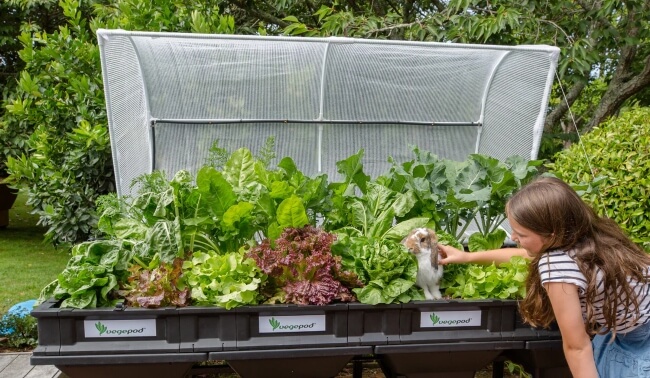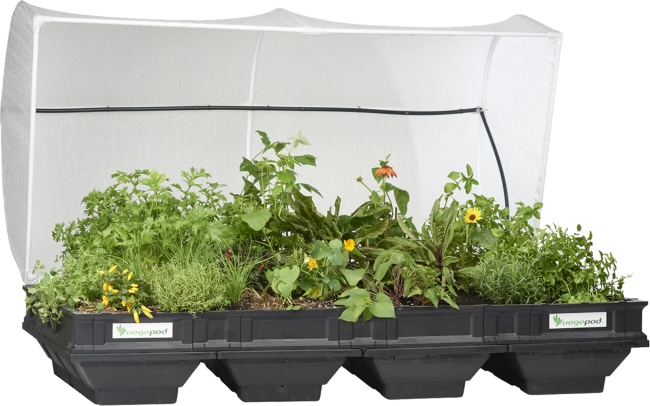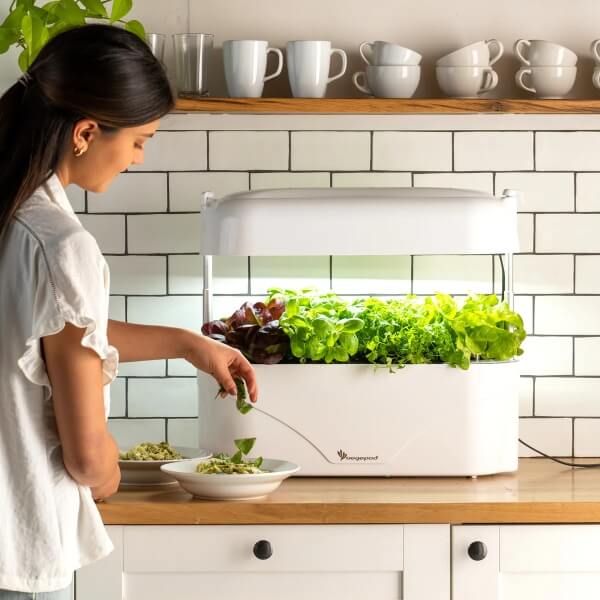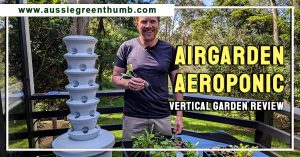Gardens are changing. They are becoming mixed spaces, where our desires to create beautiful spaces are merging with two key considerations: growing our own food, and creating spaces for wildlife. It is possible to do all three without compromising on either, and tools like the Vegepod make it infinitely easier.
We have been using a large Vegepod raised garden bed for a few months now, and apart from a few hiccups at first, it has been one of the most useful bits of gardening kit we’ve ever had. Here, I want to share those experiences, good and bad, so you have a better idea of whether this sort of garden set-up is right for you.
More...
After using the Vegepod Raised Garden Bed for a year - My overall verdict
The Vegepod was purchased for my mother-in-law to help her brown thumb, give her a great height garden, somewhere she can grow her herbs and salad vegetales and apparently pest free.
Plant Growth
The rate of growth was nothing special and the same plants in the garden were growing at the same pace or quicker. The sorrell and tarragon were both outliers and went really well. But parsley stayed small, silverbeet also never got to full size.
Read our list of plants grown further in the post.
Vegepod Pests
I routinely assisted and helped with planting and pest control. The claim is htat it is pest free, this is false. There was and still is a constant problem with aphids, moths and snails.
Aphids can easily fit through the shade cloth. Same with small moths which you would think not a big deal, what the issue was they could get in but not get out so they would enjoy the paradise of herbs and lettuces to mate and lay their eggs.
Whenever the sorrell or parsley was brushed with a hand mohs would fly out. The garden was decimated by their caterpillars.
The third pest that became present was tiny snails, not your usual garden snail, maximum length 5mm. Where they came from and how they got in there no idea, but they also bred like crazy.
Our pest solution
We removed the every plant and the top inch of soil, left it for a month then added some compost and potting mix and replanted new seedlings and seeds. The snails and moths returned but the aphids did not (wrong season, will keep you updated in Spring).
Vegepod Overall Score
Since the Vegepod is not mine, I asked my Mother-in-law for her score and for the effort to reward and ease of use she gave a score of 4/10.
The concept of the product is great but it didnt follow though with it's promises. My Mother-in-law is a bit of a brown thumb, so did that have something to do with it, maybe, but the moths getting in and breeding was the biggest issue and not matter how good of a gardener you are it would still happen.
If she had her time again she would have prefered a vertical garden either Mr Stacky or Airgarden after seeing how well mine grow and such little effort I put in most of the time (harvesting and 30min per month for up keep).


Get Your Free Guide:
Master Growing Australian Natives eBook
A Must Have Complete Guide for Every Australian Garden
Get Your Free Guide:
Master Growing Australian Natives eBook
A Must Have Complete Guide for Every Australian Garden
Introducing the Vegepod Brand

Source: Vegepod
Vegepod is an Australian-based gardening brand, with a passionate and dedicated team. They don’t just sell products, they offer advice and support too. If you get stuck with anything in their range, they are always happy to help and know their entire range inside out.
Thankfully, because it is a fairly limited range (all designed to complement one and other) it’s simple enough to navigate. That also means they can take better care when it comes to quality too.
Like everything in gardening, there are practical things that will not suit everybody (their kits are heavy when filled, and really bulky), but those problems can be a beautiful bonus to others – particularly if you’re looking to maximise space without digging up your lawn.
Vegepod Raised Garden Beds Review
We started out with a Vegepod Large Starter Pack with Stand. It comes with pretty much everything you need to get started other than the compost, so you can use the best compost for whatever you intend to grow.
Our setup guide shares our experience of putting the whole kit together, and an insight into how easy it was to use. We got a decent crop of lettuce, kale, spinach, and parsley while we were testing it out, but tarragon (which we will come back later) did not seem to enjoy it much thanks to the high moisture levels in each section.
The entire experience has been a joy, and the crops we got were delicious and really easy to grow. The only downsides, as we will cover more later, were around managing irrigation and the weight and size of the whole kit. But, in reality, if you want to grow more, it’s a space-efficient way to do it, and well worth the bulk.
The Vegepod Range
To review our raised Vegepod bed in more detail, we have taken a look at the whole range of Vegepod gardens, in the hope it gives you some guidance about how to put together the right kit for you.

Source: Vegepod
Vegepod Raised Garden Beds
There are three sizes of garden beds to choose from, and they can all be adapted to suit your space. Each works in exactly the same way and is supplied with an insect-mesh. We used the large raised garden bed and found it offered easily enough space to grow for the two of us.
The three sizes of Vegepod beds available are:
- Small Raised Garden Bed (0.5m x 1m base)
- Medium Raised Garden Bed (1m x 1m base)
- Large Raised Garden Bed (2m x 1m base)
We have been using the large Vegepod for about four months, and have a great crop of leafy vegetables, including lettuces and brassicas, and it has been one of the most generously spaced garden growing systems we have had the pleasure of using.
However, it is not without its problems:
- There is no gauge to know when the reservoir is empty.
- The top soil tends to look dry when there is water left.
- It is incredibly heavy when filled and requires at least four people to move.
- Wheels and trolleys are expensive (but you can fit your own wheelbases to the stands to save money).
But, for each of those cons, there are pros to match.
For example, it is only heavy because of its size. The large Vegepod takes about 480 litres of compost and perlite in total, which is a huge amount of root space. And while the reservoir system would benefit from a water gauge, it is deep enough that it benefits more plants than it harms.
The only practical advice I would add, in addition to the information from Vegepod themselves, is that perlite is essential.
The weight of the large Vegepod is too much for one person to move around. Adding plenty of perlite to your potting mix will help to lighten the overall weight and you could even add a layer of pure perlite to the base for shallow-rooted plants, or plants that like drainage.
Vegepod Fertilisers, Feeds and Soil Amendments
It is probably important to say that Vegepod is not a budget brand. They make really good quality garden equipment, but it comes at a price.
Their fertilisers and feeds are excellent general-purpose products, but you can actually pick up feeds and fertilisers for less at your local garden centre, and perlite (which we strongly advise) is much cheaper elsewhere if you can find a good supplier.
For Mediterranean herbs, and anything that requires good drainage, it is essential that you invest in extra perlite for the Vegepod kit. As we mentioned earlier, there is no way to gauge the reservoir water levels, and the top soil dries out quickly.
For plants like tarragon (which we tried to grow) there is simply too much water retained in the reservoir to grow them successfully, and I suspect you might have the same problem with thyme, rosemary or even basil.
You can buy extra nutrients directly from Vegepod, but they are just standard veggie feeds. Save money with standard fertilisers from your local garden centre unless you are looking for convenience.
There is a good range of soil amendments and additives online.
Covers and Shades from Vegepod
Like anything in Australia, there is always going to be a question of how you use and manage the mesh, because it will create a microclimate.
When we grew lettuce, kale, spinach and parsley, we got some aphids and fungus gnats, but the standard kits are supplied with covers. For much of Australia, you might be better off with insect netting to prevent pests, rather than shade netting, but there is plenty of choice on the website.
Vegepod Stands and Trolleys
When it comes to trolleys and stands, I would definitely recommend Vegepod’s own stands or trolleys for the small and medium kit, but for the large raised bed, they don’t actually make them.
The stands are fine and will support the weight of the larger kit, but the movable trolleys cannot take the weight, so you will either need to get friends and family to help move it around the garden if necessary, or just live with it in one place.
For a more permanent solution, it is worth speaking to a local welder who might be able to build something more durable for larger kits.
Vegepod trolleys and stands can be bought separately.
Vegepod Kitchen Gardens

Source: Vegepod
If you are after something a little smaller, Vegepod also has a beautiful range of mini kitchen gardens for windowsill planting and herbs. They are nowhere near the size, and you will need to supply your own soil, but they have one big advantage over the larger kits – they have a watering gauge so you know exactly when to water and feed your crops.
Check out the smaller range of Vegepod Kitchen Gardens.
Putting Together a Vegepod Starter Kit
The Vegepod kit we used was really easy to put together. It took us about two hours to assemble (with a few mistakes along the way).
The instructions are pretty straightforward, but familiarise yourself with the components beforehand (we got a few things back to front and had to reassemble them later).
Once the kit is together, make sure it is positioned somewhere with enough space for the lid to open. If the lid is opening backwards, it needs about 1m to swing. If it is opening upwards, it’s over 2m tall and nearly 3m tall in total if the raised beds are on a stand.
Before filling, I would recommend spending time with the kit in the garden and getting used to it. Make sure you are happy with its position, because it takes at least four people to move it safely once it’s filled with compost.
Then fill it with a layer of perlite, followed by compost, mixed with perlite. Water the soil mixture and let it settle and dry off before planting. It will sink and you might need to add extra compost later.
Frequently Asked Questions About Vegepod Gardens
Can you grow tomatoes in the Vegepod raised garden?
So far, we have only grown salads and brassicas in our Vegepod raised bed, but brassicas are usually more dependent than tomatoes, so I would say that tomatoes are definitely possible, as are other tall veggies like beans or peas.
How often should I feed and fertilise plants in the Vegepod?
According to Vegepod, you will need to top up your soil with fertilisers every 2-4 weeks, but in all honesty, it depends far more on the plant you are growing, than the container they are in. For tomatoes, feed them every other water through the growing season, but for lettuce, you can usually add a slow release on day one, and that is enough.
What can I grow in my Vegepod?
Vegepods have huge root spaces and water-saving reservoirs, so you can grow pretty much anything in them. We have had some trouble growing anything that needs really good drainage, but after a while, you get used to watering regularly and can adapt soil moisture to suit most plants.
Why do I have pests in my Vegepod garden?
Vegepod gardens are supposed to be pest-proof, but that is only as good as the mesh they come with. If you keep the mesh cover down on your Vegepod garden, you are very unlikely to get common garden pests, but when you leave it open, aphids and other flying bugs can get in. Equally, compost can contain mites and larvae.
What is the difference between mesh canopies and shade covers?
Vegepod mesh canopies are designed to keep bugs out but let light in. Shade covers allow a little bit more ventilation but with darker fabric, offering cooler conditions for your veggies. They still keep out most pests and allow you to grow more sanative crops in hot Aussie summers.
Can rats get into my Vegepod?
Rats can get into Vegepods, but we have not had any problems with that here. Once your Vegepod is on a trolley it is safe from any large pests. At ground level, rats are capable of chewing through the mesh, so we would recommend raising your Vegepod off the ground if rodents are an issue.
Overall Experience of the Vegepod Raised Garden Bed
Overall, the Vegepod raised garden beds have been an incredibly successful experiment. They produced plenty of greens, and we will keep growing with them again next year, hopefully with some more ambitious fruiting veggies.
Because of their size, we’ve been watering with a retractable hose reel for convenience, adding fertiliser by watering cans when needed. Once the stands were set up though, they meant we could grow everything we wanted, without losing any garden space. The stand below just because of a handy storage space (a great unexpected bonus).
There have been some problems with the overall weight, and they take slightly more soil to fill than we expected, but Vegepod still gets an enthusiastic green thumbs up from Aussie Green Thumb.
Published on January 3, 2025 by Nathan Schwartz
Last Updated on September 20, 2025




